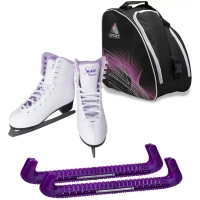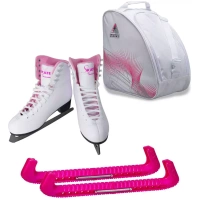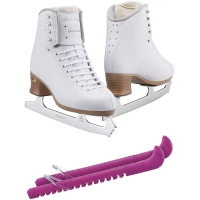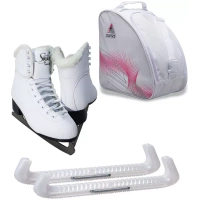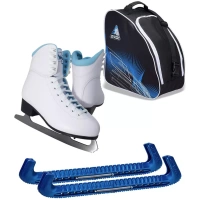Ice skating is a healthy pastime that improves mood and gives you energy. For the hobby to be safe, amateurs and professionals know all the ins and outs of sharpening skates.
Here are some comprehensive answers to common questions about sharpening skates.
How does the process of skate sharpening work?
Look at the bottom of your figure or hockey skates. You will notice that the blades have not one edge (like a knife), but two with a hollow between them. This shape is created, when the blades pass the grinding wheel (also called finishing wheel). If you divide the wheel into two semicircular pieces, you will see that the cross-sectional edge is rounded, resembling a segment of a circle.
The bottom of your blade gets this rounded shape after passing the blade along with the wheel. Your skate is then clamped into a jig aligned with the finishing wheel. The blade passes the finishing wheel about ten times until the bottom is fully hollowed out and the edges are sharp enough.
Sometimes, to prep, the blade for finishing, an extra wheel (called a cross-grinder) is used prior to the finishing wheel. Unlike the finishing wheel, it runs perpendicular to the blade, which is designed to dull and flatten the blade. It is mostly used to ‘reset’ the blade to a blank slate when you need to remove defects after bad sharpening, rust, burrs, etc. It is also used before the first sharpening of the figure or hockey skates.
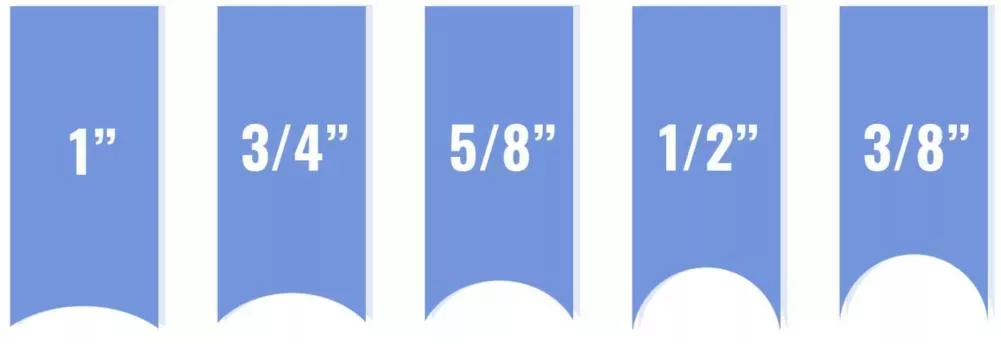
Smaller radius of hollow (eg. ⅜”)
- Deeper cut on skates
- Better suited to lighter players who dig in less to start with
- More energy lost into ice
- Extra effort required to skate
- Lower top speed
- More responsive turns and stops
- Quicker, more explosive acceleration
Larger radius of hollow (eg. ⅝”)
- Flatter cut on skates
- Better suited to heavier players who have no trouble gripping the ice
- Less energy lost into ice
- More efficient skating
- Faster top speed
- Turns and stops will be less quick or sharp
- Acceleration is more limited
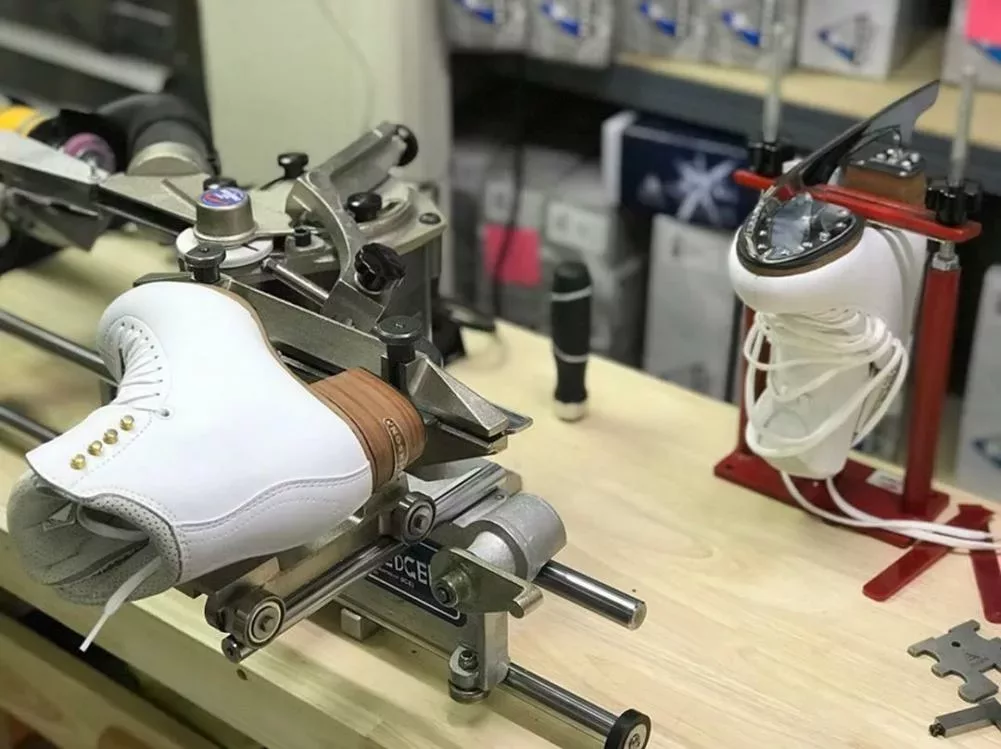
How often should ice hockey skates be sharpened?
This varies from person to person. If you want to play hockey or try figure skating, you should know that some hockey and figure skaters need frequent sharpening, sometimes after two or three hours of ice time. Others prefer to skate the entire season and sharpen when it is finished. If you aren’t sure of how often you need sharpening, try skating for about ten hours, and then go with the feeling. If you start losing balance or control of the ice skating blades, then it is time. After some practice, you will know your personal sharpening frequency.
Also the colder the ice (for example, on outdoor skating rinks), the harder it is. This adversely affects the sharpness of the hockey skating blades, as well as tiles, metal sills or uneven ice. So consider sharpening your skates more after you’ve skated in these conditions since dull blades can lead to injuries and falls.
Do new skates need sharpening?
If you have recently bought new skates, keep in mind that the blades have a certain profile radius. This radius varies between specific models of skates. Many people are mistaken, believing that the factory profile of the blade is ideal for the absolute majority. Let’s say, the factory profile shows tolerable results, but why not make the best of it?
A good way to prep new comfort skates before sharpening is cross-grinding. It removes rust, uneven edges, and other imperfections. The cross-grind runs perpendicular to the blade of the skate, unlike the finishing wheel. This way, the shape of the blade isn’t imparted. It resets the bottom of the blade to be flat, ensuring that it is perfectly aligned with the finishing wheel. This can, however, remove more steel than the finishing wheel. If your skates undergo a full cross-grind after every sharpening, your blades will have a much shorter lifespan than without cross-grinding. To prolong your blades’ life, you can ask for an extremely light cross-grind, when they don’t remove the entire hollow, but only take off the edges. Despite any type of skates, blades should be sharp.
How sharp should hockey skating blades be for beginners?
The sharpness of skates is determined through the radius of the hollow. It is ground into the bottom of your blades during sharpening and defines the inside and outside edges. How deep you should have your skates sharpened depends on your skating style and what is most comfortable for you.
For tight turns and quick acceleration, go for a smaller radius that will give you more bite into the ice. However, bear in mind that it will cause greater friction and lessen glide and speed since the edges will dig deeper into the ice. Also, a bigger radius will be less durable and more fragile.
So a bigger radius will give you greater glide and speed (take speed skater’s blades, for instance – they are absolutely flat!). It will cause less fatigue, but also less maneuverability, so choose wisely and consider all the pros and cons of your skating style.
Another variable to consider is weight. Generally, the heavier you are, the larger radius you need. Light skaters can tolerate a smaller radius because they do not bear a lot of weight on the ice. Heavier skaters trying to skate on a smaller radius will bite into the ice and have trouble stopping without going over the top of the skates or chattering. On the other hand, they can hold tight turns. If you are a beginner, you should remember that most skills are easier to learn with a larger hollow radius. As they progress, you can decrease the radius to a normal level.
One more thing to consider is the ice temperature. Most ice skating rinks have ice temperature of about 25 degrees Fahrenheit (-4 degrees Celsius). A temperature of 17-23 degrees Fahrenheit (-8 -5 degrees Celsius) is considered hard ice, and 25-26 degrees (-4 -3 degrees Celsius) is good figure skating ice. When skating on colder/harder ice, you should use a smaller hollow radius and vice versa.
What are the common sharpening mistakes to watch out for?
There are two common major problems you can encounter after you have your skates sharpened. It is not the end of the world, but either way, the best solution would be to have them re-sharpened.
The first major issue is improper alignment. This happens when the skate blade wasn’t properly aligned with the grinding wheel, which makes one edge taller than the other. You will have a good bite when you turn or stop in one direction, but going the other way, you will feel like slipping out. Another way to notice that is to look down the length of your blade. You might see that one edge is higher than the other one. You can also balance a coin or any other flat object on the top of the blade to see if it’s tilted.
The second skate sharpening mistake occurs when the skates are not fully sharpened. That means that they were cross-ground but not hollowed back out completely. After flattening the blade from the cross-grind, the sharpener had to pass it over the finishing wheel enough times to regain its edge. Your skates will have a little bit, which will make pushing, turning, or stopping much harder.
To identify this mistake, look at the bottom of the blade. You will see two thin lines that run down the edges with a slight difference in shine or color. If you notice this on one edge of each blade, the skates were not fully sharpened and improperly aligned.
Some minor sharpening mistakes still make it possible to skate but will be a sign your hockey shop doesn’t put much effort into this. Next time you will know better when you choose where to take your skates for sharpening.
These minor issues include:
- unnecessary cross-grinding (which reduces blades’ lifespan),
- over-sharpening the tip and/or tail (which gives your hockey skate a ‘banana’ look; this will lead to an imbalance of the skate and lack of support for the blade.),
- going too hard/too fast over the sharpening wheel (which can cause burrs and rough spots on the edges, or make the blade discolored and slightly uneven).
Don’t be afraid to experiment with different sharpening techniques and hollow radii. After all, they all have specific advantages and disadvantages. You can always ask a legit sharpener for tips at the counter, but don’t hesitate to do some homework yourself.
